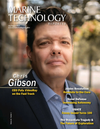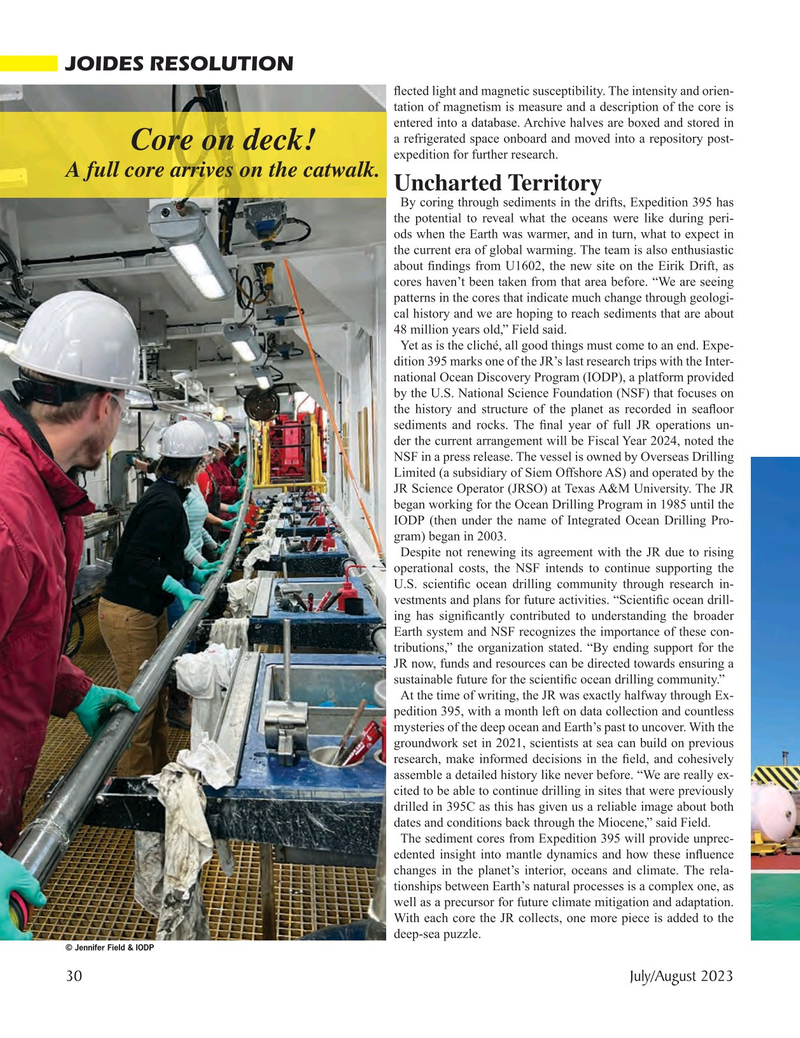
Page 30: of Marine Technology Magazine (July 2023)
Read this page in Pdf, Flash or Html5 edition of July 2023 Marine Technology Magazine
JOIDES RESOLUTION ? ected light and magnetic susceptibility. The intensity and orien- tation of magnetism is measure and a description of the core is entered into a database. Archive halves are boxed and stored in a refrigerated space onboard and moved into a repository post-
Core on deck! expedition for further research.
A full core arrives on the catwalk.
Uncharted Territory
By coring through sediments in the drifts, Expedition 395 has the potential to reveal what the oceans were like during peri- ods when the Earth was warmer, and in turn, what to expect in the current era of global warming. The team is also enthusiastic about ? ndings from U1602, the new site on the Eirik Drift, as cores haven’t been taken from that area before. “We are seeing patterns in the cores that indicate much change through geologi- cal history and we are hoping to reach sediments that are about 48 million years old,” Field said.
Yet as is the cliché, all good things must come to an end. Expe- dition 395 marks one of the JR’s last research trips with the Inter- national Ocean Discovery Program (IODP), a platform provided by the U.S. National Science Foundation (NSF) that focuses on the history and structure of the planet as recorded in sea? oor sediments and rocks. The ? nal year of full JR operations un- der the current arrangement will be Fiscal Year 2024, noted the
NSF in a press release. The vessel is owned by Overseas Drilling
Limited (a subsidiary of Siem Offshore AS) and operated by the
JR Science Operator (JRSO) at Texas A&M University. The JR began working for the Ocean Drilling Program in 1985 until the
IODP (then under the name of Integrated Ocean Drilling Pro- gram) began in 2003.
Despite not renewing its agreement with the JR due to rising operational costs, the NSF intends to continue supporting the
U.S. scienti? c ocean drilling community through research in- vestments and plans for future activities. “Scienti? c ocean drill- ing has signi? cantly contributed to understanding the broader
Earth system and NSF recognizes the importance of these con- tributions,” the organization stated. “By ending support for the
JR now, funds and resources can be directed towards ensuring a sustainable future for the scienti? c ocean drilling community.”
At the time of writing, the JR was exactly halfway through Ex- pedition 395, with a month left on data collection and countless mysteries of the deep ocean and Earth’s past to uncover. With the groundwork set in 2021, scientists at sea can build on previous research, make informed decisions in the ? eld, and cohesively assemble a detailed history like never before. “We are really ex- cited to be able to continue drilling in sites that were previously drilled in 395C as this has given us a reliable image about both dates and conditions back through the Miocene,” said Field.
The sediment cores from Expedition 395 will provide unprec- edented insight into mantle dynamics and how these in? uence changes in the planet’s interior, oceans and climate. The rela- tionships between Earth’s natural processes is a complex one, as well as a precursor for future climate mitigation and adaptation.
With each core the JR collects, one more piece is added to the deep-sea puzzle. © Jennifer Field & IODP 30 July/August 2023
MTR #5 (18-33).indd 30 7/21/2023 9:09:20 AM

 29
29

 31
31
